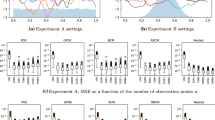Abstract
This paper is a review of the “State of the Art” in recovery estimation, from the theoretical and practical point of view. After a recall on early methods, some of them being still usefull, the main methods currently employed are compared in the case of point recovery: namely indicator kriging, disjunctive kriging, conditional distribution. The pratice of each method is reviewed then in the important case of block recovery, including a comparison of the change-of-support methods involved.
Access this chapter
Tax calculation will be finalised at checkout
Purchases are for personal use only
Preview
Unable to display preview. Download preview PDF.
Similar content being viewed by others
References
CGMM refers to Centre de Geostatistique et Morphologie Mathématiques, 35 rue Saint Honoré — 77300 FONTAINEBLEAU APCOM refers to the various conferences named: “Application of Computer methods to the Mining Industry”.
Beckmann P. (1973): “Orthogonal polynomials for engineers and physicist” Cohen Press, Boulder, Co.
Bouchind’homme JF (1980): “Estimation de l’Uranium récupérable sur les gisements sédimentaires stratiformes exploitables à ciel ouvert” Doctor Ing. Thesis University of Nancy, INPL.
David M. (1972): Grade tonnage curve, use and misuse in ore reserve estimation. Trans. Inst. Min. Metall., p: 129, 132.
David M. (1973): Dagbert M. and Besliles JM. (1977): “The practice of porphyry copper deposit estimation for grade and ore-waste tonnage demonstrated by several case studies”. Pro. 15th APCOM, AUSTRALIAN I. M.M. Parkville.
David M. (1977): “Geostatistical ore reserve estimation” Elsevier 1977. p: 313, 320.
Guibal D., Remacre A. (1983): “Local estimation of recoverable reserves: comparing various methods witch the reality on a porphyry copper deposit” to be published on the proceeding, NATO-ASI TAHOE-83.
Jackson M., Marechal A. (1979): “Recoverable reserves estimated by disjunctive kriging: a case study” Proceeding, 16th APCOM, S.M.E-AIME, New-York.
Journel A. (1973): “Le formalisme des relations ressources-reserves, Simulations de gisements miniers”, Revue de l’Industrie Minérale, section Mines 4. p: 214, 226.
Journel A. (1980): “The lognormal approach to predicting local distributions of selective mining unit grades” Mathematical Geology, Vol 13.
Journel A. (1982): “Indicator approach to spatial distributions” Proc. of 17 APCOM, Denver, published by AIME
Journel A. (1983): “Nonparametric estimation of spatial distributions” Math. Geology, Vol 15 n° 3.
Journel A, Huijbregts Ch. (1978): “Mining geostatistics” Academic Press, London.
Marbeau JP., Marechal A. (1980): “Geostatistical estimation of uranium ore reserves”. Invited review paper in “Uranium evaluation and mining techniques” IAEA Vienna 1980
Marechal A. (1972a): “El problema de la curva tonelage-ley de corte y su estimation” Boletin de geostatistica, Vol 1 (May 1972 ). Universidad de Chile, Satiago.
Marechal A. (1972b): El problema de la estimation de la distribution local de leyes, Bol Geostatistica Vol 4, n° 72. p: 55, 69.
Marechal A. (1974): “Généralités sur les fonctions de transfert” Internal Report M-384 CGMM.
Marechal A. (1975): Analyse numérique des anamorphosees gaussiennes. Internal Report CGMM 1975.
Marechal A. (1975): “Forecasting a grade-tonnage distribution for various panel sizes” Proceedings, 13th APCOM Clausthal, R.F.A.
Marechal A., Touffait Y. (1980): “Recovery estimation of non-stationary orebody using disjunctive kriging”. Proceedings, Computer methods for the mining industry Meeting Moscou 1980.
Marechal A. (1982): “Local recovery estimation for co- products by disjunctive kriging”. Proceeding of 17th APCOM, Denver, AIME.
Matheron G. (1972): “Le krigeage disjonctif”. Internal report CGMM.
Matheron G. (1974): “Les fonctions de tranfert des petits panneaux”. Internal report N-395. CGMM.
Matheron G. (1976): “Forecasting block grade distributions: the tranfer functions”. Proceedings 15th NATO-ASI “Advanced geostatistics in the mining industry”.
Matheron G. (1978): “Peut-on imposer des conditions d’universalité au krigeage?”. Internal report n° CGMM.
Matheron G. (1980): “Modeles isofactoriels pour l’effet zero”. CGMM Internal Report N-659 June 1980.
Matheron G. (1981a): “Remarques sur le changement de support”. Internal Report n° N-690 Feb. 1981. CGMM.
Matheron G (1981b): “La sélectivité des distributions”. Internal Report n° N-686 Feb. 1981. CGMM.
Matheron G. (1982): “La déstructuration des hautes teneurs et le krigeage des indicatrices”. Internal Report N-761. CGMM.
Matheron G. (1983): “Isofactorial models and change of support” to be published in Proceedings, NATO-ASI. TAHOE-83
Verly G. (1983): “The multigaussian approach and its applications to the estimation of local recoveries”. Mathematical Geology, Vol. 15. n° 2.
Muge F. (1982): “The role of recuperation functions in the early stage of the mine planning of an iron orebody”. Proceedings of 17th APCOM, AIME Publications.
Parker H. (1975): “The geostatistical evaluation of ore reserves using conditional probability distributions: a case study for the area 5 Prospect, Warren, Maine”. Ph. D. Thesis, Stanford University.
Parker HM. (1975) and Switzer P.: Use of conditional probability distribution in ore reserve estimation, a case study. Proc. 13th APCOM Symp. Clausthal, W. Germany.
Parker H., Journel A., Dixon W. (1979): “The use of conditional lognormal probability distribution for the estimation of open-pit ore reserves in strata-bound Uranium deposit”. 16th APCOM Proceeding AIME, AIME, Publications.
Williamson D.R. and Mueller E, (1976): “Ore estimation at Cyprus Pima Mine”. AIME Annual Meeting. Las Vegas (1976).
Author information
Authors and Affiliations
Editor information
Editors and Affiliations
Rights and permissions
Copyright information
© 1984 D. Reidel Publishing Company
About this chapter
Cite this chapter
Marechal, A. (1984). Recovery Estimation: A Review of Models and Methods. In: Verly, G., David, M., Journel, A.G., Marechal, A. (eds) Geostatistics for Natural Resources Characterization. Springer, Dordrecht. https://doi.org/10.1007/978-94-009-3699-7_23
Download citation
DOI: https://doi.org/10.1007/978-94-009-3699-7_23
Publisher Name: Springer, Dordrecht
Print ISBN: 978-94-010-8157-3
Online ISBN: 978-94-009-3699-7
eBook Packages: Springer Book Archive




